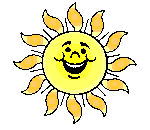


The Sun is a medium size star.
Many stars are much smaller than the Sun.
There are other stars that are much bigger.
The Sun is a yellow star. Hotter stars are blue,
and cooler stars are red.
The Sun is made up of very hot gases
( about 75% hydrogen and 25% helium).
Its surface is 5 times hotter than lava
from an erupting volcano.

Through a special telescope, you can see
flames shooting from the Sun's surface.
Sunspots, or cooler areas, can also be seen .
See a larger picture of the
SUN

Earth gets light and heat from the Sun.
The Sun heats the land, oceans and air.
Without it there would be no plants or animals.
Earth would be a dark, cold, dead place.
The Earth is 93 million miles
(150 million kilometres) from the Sun.
It would take a jumbo jet 17 years to get there.
The other planets reflect light from the Sun.
That is how we can see the other planets at night.

Staring at the Sun will damage your eyes.
web page by J.Giannetta
1999 (updated 2009)
The image of the Sun was acquired from
NASA's Skylab space station on December 19, 1973.